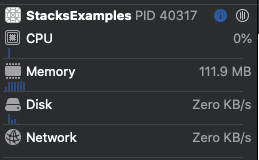

If you read the code carefully, you probably noticed that, unlike UIKit drop delegate, in SwiftUI, we create a drop delegate object for every row in the stack, again, because of the declarative nature of the framework. Note: If Xcode doesn’t recognize UTType, you need to import the UniformTypeIdentifiers framework.


In this case, the onDrop() view modifier accepts two parameters – the type of content allowed to be dragged - (UTType.text), and a delegate (conforms to DropDelegate protocol) describes the behavior of the drop. onDrop(of:, delegate: MyDropDelegate(item: item, items: $items, draggedItem: $draggedItem)) This is the variable that stores the dragged item. Notice I added a new state named “draggedItem”. Now, because SwiftUI is a declarative framework, we need to add a view modifier for each view that handle the dragging. Let’s create a simple LazyVStack, with three items only:įor the simplicity of the tutorial, the items list is an array of strings, and I also colored the views with red. It doesn’t matter what layout we choose – we can apply it to any layout since the updates are derived from data changes. Reordering items with drag and drop is relevant not only to LazyVStack but to any other layout such as LazyHStack, List, and even VStack and HStack.
#Vstack vs lazyvstack update#
Detect dragging updates and update the state according to the changes. Declare what views can be draggable and what views can receive drops. The API handles the animation and UI updates for us. Attach a dragging delegate to a UICollectionView or UITableView. The reason is that SwiftUI is a declarative framework – we describe how the UI behaves and how it is connected to the data, and the magic happens only by updating the data (“State”).īut this approach creates new challenges and changes to how we work.

While in UIKit, we are expected to synchronize the changes between the data and the UI, in SwiftUI, the framework does this job for us. “Drag and Drop” become super straightforward, and the API handles most of the cases itself.īut what happens with SwiftUI? Do we have the same simple API like UIKit? Main Difference Between SwiftUI and UIKitīoth frameworks are remarkable, but they work differently. The buttons that help in navigating between different tabs are highly customizable, meaning, they can have custom views and badges that make information delivery faster and clearer for the user.Those of you who are familiar with UIKit iOS 11 Drag and Drop API probably know that it dramatically improves UITableView and UICollectionView reordering user experience. Components can also accept parameters that make them customizable according to requirements.Ī view that allows the user to switch between multiple child views and access different forms of data without being navigated out of the screen in focus.ĭifferent child components, also known as tabs, can contain entire reusable views which can be done with the help of reusable components. A struct can be used directly in another component as a View. Reusable Custom ViewsĬreating reusable components in SwiftUI is a super easy task. It is particularly useful when we have large list of contents inside a scrollview. Our example here in grey stretches down and lists all 99 elements the VStack contains, while the top in black lists just what’s loaded in the LazyVStack. If we want to load the content into memory when we need it, we can use LazyVStack. In this article, we will continue discussing some more advanced components in SwiftUI that will help you build your awesome iOS apps. When capturing a snapshot of this hierarchy, for both the lazily and normally loaded VStacks, we’re in the exact same application state except, one is providing much more information. If I add fixedSize(horizontal: false, vertical: true) to the Text element it seems to stop stuttering. Previously, we have looked at some basic as well as some advanced components in SwiftUI. I ripped everything out in my view and built it back up one by one the LazyVStack begins to stutter as soon as I put a VStack/HStack/ZStack around a simple Text element.
#Vstack vs lazyvstack series#
Welcome back to the ongoing series on SwiftUI.


 0 kommentar(er)
0 kommentar(er)
